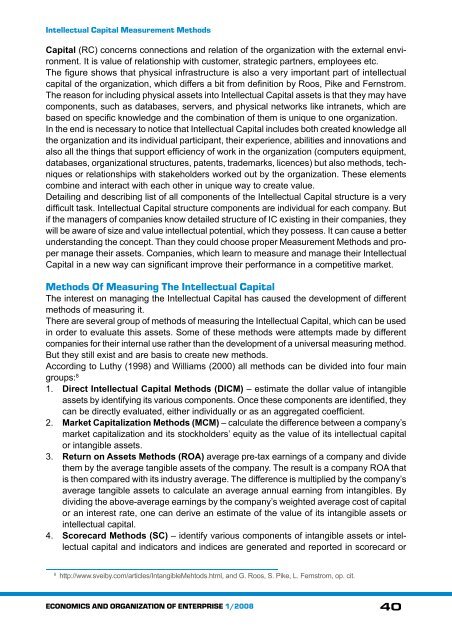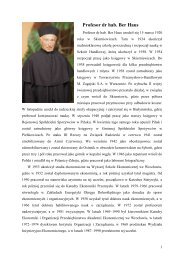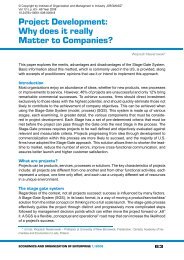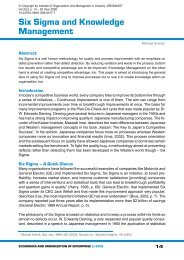Intellectual Capital Measurement Methods
Intellectual Capital Measurement Methods
Intellectual Capital Measurement Methods
You also want an ePaper? Increase the reach of your titles
YUMPU automatically turns print PDFs into web optimized ePapers that Google loves.
<strong>Intellectual</strong> <strong>Capital</strong> <strong>Measurement</strong> <strong>Methods</strong><br />
<strong>Capital</strong> (RC) concerns connections and relation of the organization with the external environment.<br />
It is value of relationship with customer, strategic partners, employees etc.<br />
The figure shows that physical infrastructure is also a very important part of intellectual<br />
capital of the organization, which differs a bit from definition by Roos, Pike and Fernstrom.<br />
The reason for including physical assets into <strong>Intellectual</strong> <strong>Capital</strong> assets is that they may have<br />
components, such as databases, servers, and physical networks like intranets, which are<br />
based on specific knowledge and the combination of them is unique to one organization.<br />
In the end is necessary to notice that <strong>Intellectual</strong> <strong>Capital</strong> includes both created knowledge all<br />
the organization and its individual participant, their experience, abilities and innovations and<br />
also all the things that support efficiency of work in the organization (computers equipment,<br />
databases, organizational structures, patents, trademarks, licences) but also methods, techniques<br />
or relationships with stakeholders worked out by the organization. These elements<br />
combine and interact with each other in unique way to create value.<br />
Detailing and describing list of all components of the <strong>Intellectual</strong> <strong>Capital</strong> structure is a very<br />
difficult task. <strong>Intellectual</strong> <strong>Capital</strong> structure components are individual for each company. But<br />
if the managers of companies know detailed structure of IC existing in their companies, they<br />
will be aware of size and value intellectual potential, which they possess. It can cause a better<br />
understanding the concept. Than they could choose proper <strong>Measurement</strong> <strong>Methods</strong> and proper<br />
manage their assets. Companies, which learn to measure and manage their <strong>Intellectual</strong><br />
<strong>Capital</strong> in a new way can significant improve their performance in a competitive market.<br />
<strong>Methods</strong> Of Measuring The <strong>Intellectual</strong> <strong>Capital</strong><br />
The interest on managing the <strong>Intellectual</strong> <strong>Capital</strong> has caused the development of different<br />
methods of measuring it.<br />
There are several group of methods of measuring the <strong>Intellectual</strong> <strong>Capital</strong>, which can be used<br />
in order to evaluate this assets. Some of these methods were attempts made by different<br />
companies for their internal use rather than the development of a universal measuring method.<br />
But they still exist and are basis to create new methods.<br />
According to Luthy (1998) and Williams (2000) all methods can be divided into four main<br />
groups: 8<br />
1. Direct <strong>Intellectual</strong> <strong>Capital</strong> <strong>Methods</strong> (DICM) – estimate the dollar value of intangible<br />
assets by identifying its various components. Once these components are identified, they<br />
can be directly evaluated, either individually or as an aggregated coefficient.<br />
2. Market <strong>Capital</strong>ization <strong>Methods</strong> (MCM) – calculate the difference between a company’s<br />
market capitalization and its stockholders’ equity as the value of its intellectual capital<br />
or intangible assets.<br />
3. Return on Assets <strong>Methods</strong> (ROA) average pre-tax earnings of a company and divide<br />
them by the average tangible assets of the company. The result is a company ROA that<br />
is then compared with its industry average. The difference is multiplied by the company’s<br />
average tangible assets to calculate an average annual earning from intangibles. By<br />
dividing the above-average earnings by the company’s weighted average cost of capital<br />
or an interest rate, one can derive an estimate of the value of its intangible assets or<br />
intellectual capital.<br />
4. Scorecard <strong>Methods</strong> (SC) – identify various components of intangible assets or intellectual<br />
capital and indicators and indices are generated and reported in scorecard or<br />
8<br />
http://www.sveiby.com/articles/IntangibleMehtods.html, and G. Roos, S. Pike, L. Fernstrom, op. cit.<br />
ECONOMICS AND ORGANIZATION OF ENTERPRISE 1/2008<br />
40







